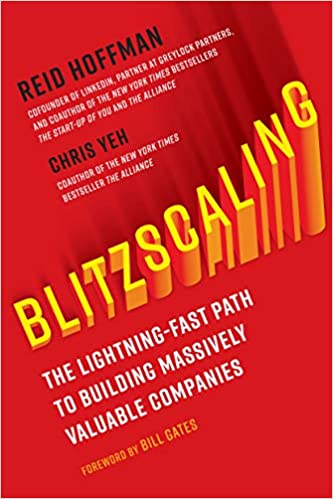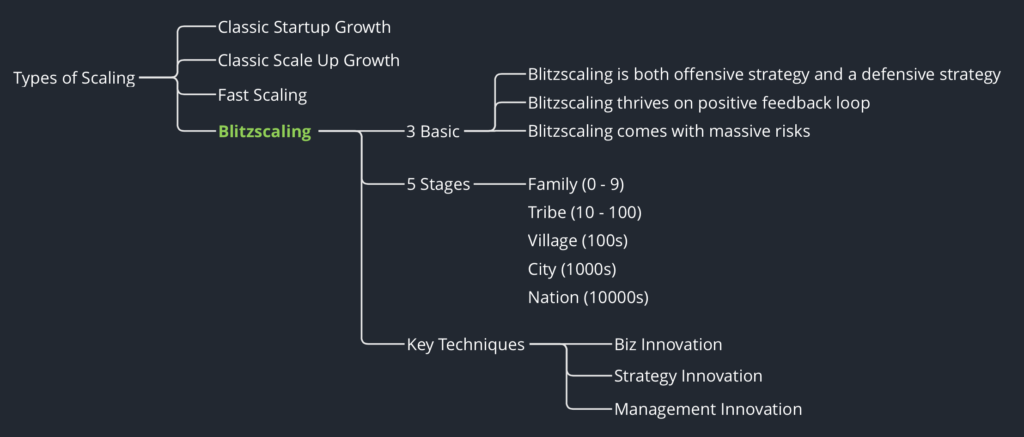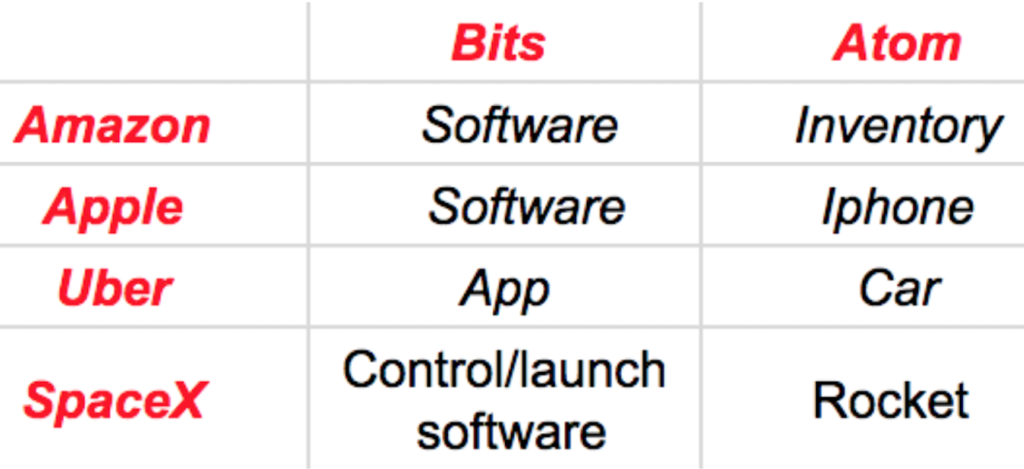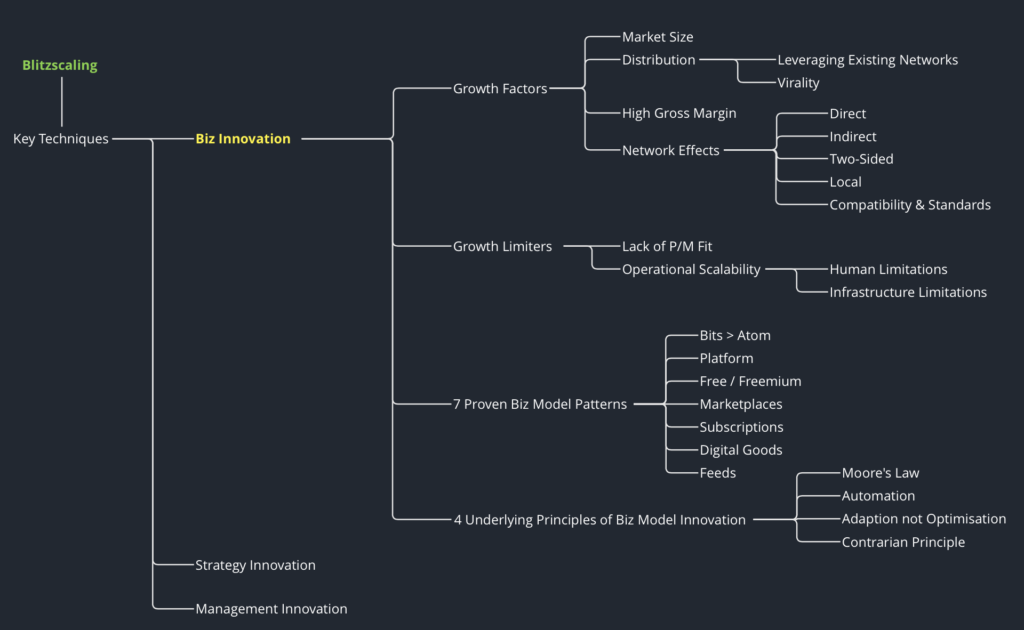
Synopsis: Blitzscaling lays out a set of frameworks and principles to help you navigate the changes and conquer the challenges on the path to global dominance.
If classic start-up growth is about slowing your rate of descent as you try to assemble your plane, blitzscaling is about assembling that plane faster, then strapping on and igniting a set of jet engines (and possibly their afterburners) while you’re still building the wings. It’s “do or die,” with either success or death occurring in a remarkably short time.
Blitzscaling by Reif Hoffman


Of the three core techniques of blitzscaling, the first and most foundational is to design an innovative business model capable of exponential growth.
Bits rather than atoms
- Most of the companies in the world majorly categorized either bits or atoms companies
- Bits: Company which builds on bits & bytes (0s & 1s) as a fundamental building block. most Internet/Software companies survive with this principle. Innovation in this area is consistently accelerating in this area. there are too many bits companies right now (WhatsApp, Google, Facebook, Twitter)
- Atoms: The smallest unit of matter. The company builds purely based on substances aka a company having physical visible products. Innovation in this area is consistently slowed down in this area.
- Bit + Atom: There is a 3rd group where the most successful companies are coming up with products and services that really do combine the best of both worlds
- Converting Atoms to Bits: The new internet age was all about the overwhelming superiority of customer experience & transforming the atoms to bits across the information superhighway. eg Books → Kindle

Feeds
- One of the most underrated and underappreciated proven patterns is the news feed. eg Instagram feed
- The power of the news feed comes from its ability to drive user engagement, which drives both advertising revenue and long-term retention.
- As Facebook has demonstrated, a news feed with sponsored updates is the most effective way to monetize proverbial Internet “eyeballs.” Facebook’s News Feed’s dominance of the online advertising market is only exceeded by Google’s AdWords, and AdWords starts with the significant built-in advantage of capturing active consumer intent rather than simply the desire to be amused.
- Facebook doesn’t just insert sponsored updates at random. The company knows your interests better than you do, based on all the items you’ve ever clicked on, liked, or otherwise engaged with. It can carefully target the advertisements it shows you based on your individual habits and the context of what surrounds them in your feed.
Adaptation not Optimisation
- At a higher level of abstraction, successful scale-ups place more emphasis on adaptation than optimization.
- This emphasis makes sense in an environment where companies need to seek product/market fit for new and rapidly changing products and markets.
Contrarian Principle
- Being contrarian is often critical to the process of creating a massively valuable technology company.
- If your company is pursuing an opportunity that nearly everyone agrees is very attractive, you’re likely to have a difficult time distancing yourself from your army of competitors. But if your company is pursuing an opportunity that conventional wisdom ignores or disdains, you will probably have the time you need to refine your business model innovation into a well-oiled machine.
- As we’ve already seen, most great ideas look dumb at first. Being a contrarian doesn’t mean that dumb people disagree with you; it means that smart people disagree with you. eg AirBnB
- The problem is that, by definition, business model innovation involves trying something that is new, and thus unproven.
- Many venture capitalists like to brag that they are masters of “pattern matching”—but here we must caution not all pattern matching is helpful. The good kind of pattern matching involves understanding what medical science terms “the mechanism of action.”

To blitzscale or not to blitzscale is a strategic (and difficult) choice. The objective of blitzscaling is to achieve “lightning” growth despite the increased risks and costs. The only time that it makes sense to blitzscale is when (whether for offensive or defensive reasons) you have determined that speed into the market is the critical strategy to achieve massive outcomes.
It does not necessarily need to have solved the revenue model before deciding to blitzscale. A key element of blitzscaling is often the willingness of investors to fund growth before the revenue model is proven—after all, it’s pretty easy to fund growth after the revenue model is proven.
When blitzscaling, the things you do to help you scale up to the next stage probably won’t allow you to scale up to the stage after that. To build a true scale-up, almost everything you do has to change with each stage. Blitzscaling extends the simple three-step process of “Do Things That Don’t Scale” as follows:
- Do things that don’t scale
- Reach the next stage of blitzscaling
- Figure out how to do one set of things that scale, while somehow also finding a way to do a completely different set of things that don’t scale
- Reach the next stage of blitzscaling
- Repeat over and over until you reach complete market dominance
Successful blitzscalers have to implement management innovations to steer their burgeoning organizations through their growing pains.
Generalist → Specialists
- During the early stages of blitzscaling, the need for speed and adaptability places a hefty premium on hiring smart generalists who can get many different things done in an uncertain and rapidly changing environment. But as the company grows, it needs to shift to hiring specialists who are less fungible but have expertise in an area that is crucial to scaling the organization.
- One of the main benefits of bringing on specialists is that it allows you to redeploy capable generalists to attack your most pressing challenges.
- Think of generalists as the “stem cells” of your organisation. Your body has a small number of stem cells that have the capability to morph into various other types of cells as needed.
◃ Back

